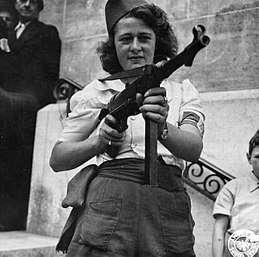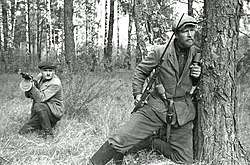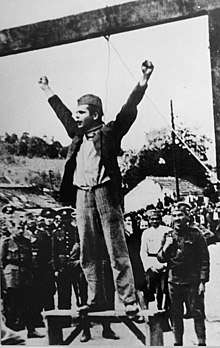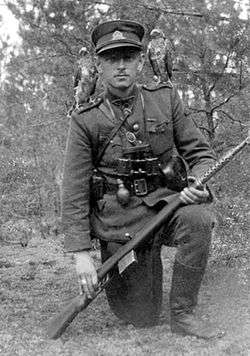Partisan (military)
A partisan is a member of an irregular military force formed to oppose control of an area by a foreign power or by an army of occupation by some kind of insurgent activity. The term can apply to the field element of resistance movements. The most common use in present parlance in several languages refers to occupation resistance fighters during World War II.

History
The initial concept of partisan warfare involved the use of troops raised from the local population in a war zone (or in some cases regular forces) who would operate behind enemy lines to disrupt communications, seize posts or villages as forward-operating bases, ambush convoys, impose war taxes or contributions, raid logistical stockpiles, and compel enemy forces to disperse and protect their base of operations.
One of the first manuals of partisan tactics in the 18th century was The Partisan, or the Art of Making War in Detachment..., published in London in 1760[1] by de Jeney, a Hungarian military officer who served in the Prussian Army as captain of military engineers during the Seven Years' War of 1756–1763. Johann von Ewald described techniques of partisan warfare in detail in his Abhandlung über den kleinen Krieg (1789).[2]
The concept of partisan warfare would later form the basis of the "Partisan Rangers" of the American Civil War. In that war, Confederate States Army Partisan leaders, such as John S. Mosby, Jesse James, William Quantrill, or Bloody Bill Anderson, operated along the lines described by von Ewald (and later by both Jomini and Clausewitz). In essence, 19th-century American partisans were closer to commando or ranger forces raised during World War II than to the "partisan" forces operating in occupied Europe. Mosby-style fighters would have been legally considered uniformed members of their state's armed forces.
Partisans in the mid-19th century were substantially different from raiding cavalry, or from unorganized/semi-organized guerrilla forces. Russian partisans played a crucial part in the downfall of Napoleon. Their fierce resistance and persistent inroads helped compel the French emperor to retreat from Russia after invading in 1812.
During the Second Boer War, the Boers waged a successful guerrilla campaign against the British.
Imperial Russia also made use of partisans in World War I, for example Stanisław Bułak-Bałachowicz.
By region
Italian
In 1922, Benito Mussolini and Fascist troops entered Rome. One of the most important episodes of resistance by Italian armed forces after the armistice was the battle of Piombino, Tuscany.[3] On 10 September 1943, during Operation Achse, a small German flotilla, commanded by Kapitänleutnant Karl-Wolf Albrand, tried to enter the harbour of Piombino but was denied access by the port authorities.[3]
Polish
The order to organize partisan groups was issued by Marshal of Poland Rydz-Smigly on the 16th of September, 1939. The first sabotage groups were created in Warsaw on September 18, 1939. Each battalion was to choose 3 soldiers who were to sabotage enemy's war effort behind the front lines. The sabotage groups were organized before Rydz-Smigly's order was received.
The situation amongst the Polish partisans and the situation of the Polish partisans were both complicated. The founding organizations that lead to the creation of the Home Army or Armia Krajowa, also known as AK, were themselves organized in 1939. Home Army was the largest Polish partisan organization; moreover, organizations such as peasant Bataliony Chlopskie, created primarily for self--defence against the Nazi German abuse, or the armed wing of the Polish Socialist Party and most of the nationalist National Armed Forces did subordinate themselves, before the end of the World War II, to the very Home Army. The communist Gwardia Ludowa remained indifferent and even hostile towards the Home Army, and of two Jewish organizations, the Jewish Military Union did cooperate with the Home Army, when the leftist and pro-Soviet Jewish Combat Organization did not.
Both Jewish combat organizations staged the Ghetto uprising in 1943.
Armia Krajowa staged Warsaw Uprising in 1944, amongst other activities.
Bataliony Chlopskie fought mainly in Zamosc Uprising.
The Polish partisans faced many enemies. The main enemies were the Nazi Germans, Ukrainian nationalists, Lithuanian Nazi collaborators, and even the Soviets. In spite of the ideological enmity, the Home Army did launch a massive sabotage campaign after the Germans began Operation Barbarossa. Amongst other acts of sabotage, the Polish partisans damaged nearly 7,000 locomotives, over 19,000 railway cars, over 4,000 German military vehicles and built-in faults into 92,000 artillery projectiles as well as 4710 built-in faults into aircraft engines, just to mention a few and just in between 1941 and 1944.
In Ukraine and southeastern Poland, the Poles fought against the Ukrainian nationalists and UPA (Ukrainian Insurgent Army) to protect the ethnic Poles from mass murder visited upon them during Massacres of Poles in Volhynia and Eastern Galicia. They were aided, until after the war was over, by the Soviet partisans. At least 60,000 Poles lost their lives, the majority of them civilians, men, women, and children. Some of the victims were Poles of Jewish descent who had escaped from the ghetto or death camp. The majority of the Polish partisans in Ukraine assisted the invading Soviet Army. Few of them got mistreated or killed by the Soviets or the Polish communists.
In Lithuania and Belarus, after a period of initial cooperation, the Poles defended themselves against the Soviet partisans as well as fought against the Lithuanian Nazi collaborators. The Poles failed to defeat the Soviet Partisans, but did achieve a decisive victory against the Lithuanian Nazi collaborators, Battle of Murowana Oszmianka. Afterward, about half of the Polish partisans in Lithuania assisted the invading Soviet Army, and many ended up mistreated and even killed by the Soviets and the Polish communists.
Ukrainian
The Ukrainian Insurgent Army (Ukrainian: Українська Повстанська Армія (УПА), Ukrayins’ka Povstans’ka Armiya; UPA) was a Ukrainian nationalist paramilitary and later partisan army that engaged in a series of guerrilla conflicts during World War II against Nazi Germany, the Soviet Union, Czechoslovakia, and both Underground and Communist Poland. The group was the military wing of the Organization of Ukrainian Nationalists—Bandera faction (the OUN-B), originally formed in Volyn in the spring and summer of 1943. Its official date of creation is 14 October 1942,[4] day of Intercession of the Theotokos feast.
The OUN's stated immediate goal was the re-establishment of a united, independent national state on Ukrainian ethnic territory. Violence was accepted as a political tool against foreign as well as domestic enemies of their cause, which was to be achieved by a national revolution led by a dictatorship that would drive out the occupying powers and set up a government representing all regions and social groups.[5] The organization began as a resistance group and developed into a guerrilla army.[6]
During its existence, the Ukrainian Insurgent Army fought against the Poles and the Soviets as their primary opponents, although the organization also fought against the Germans starting from February 1943. From late spring 1944, the UPA and Organization of Ukrainian Nationalists-B (OUN-B)—faced with Soviet advances—also cooperated with German forces against the Soviets and Poles in the hope of creating an independent Ukrainian state.[7] The army also perpetrated ethnic cleansing of the Polish population of Volhynia and East Galicia.[8][9][10][11][12]
Soviet

Soviet partisans during World War II, especially those active in Belarus, effectively harassed German troops and significantly hampered their operations in the region. As a result, Soviet authority was re-established deep inside the German-held territories. In some areas partisan collective farms raised crops and livestock to produce food. However this was not usually the case and partisans also requisitioned supplies from the local populace, sometimes involuntarily.
Soviet partisans in Finland were known to have attacked villages and indiscriminately targeted the populace, killing entire families. The war crimes committed in Finland by Soviet partisans were investigated by the National Bureau since 1999. However, Russia refused access to Soviet archives and the investigation ended in 2003. Partisan warfare was routinely distorted in the Soviet Union. According to historian Veikko Erkkilä the Russian attitude towards civilian atrocities has been marred by the Great Patriotic War propaganda.[13] In East Karelia, most partisans attacked Finnish military supply and communication targets, but inside Finland proper, almost two-thirds of the attacks targeted civilians,[14] killing 200 and injuring 50, mostly women, children and elderly.[15][16][17]
Yugoslav

The Yugoslav Partisans or the National Liberation Army (officially the National Liberation Army and Partisan Detachments of Yugoslavia), was Europe's most effective anti-Nazi resistance movement.[18][19] It was led by the Communist Party of Yugoslavia[20] during World War II. Its commander was Marshal Josip Broz Tito. They were a leading force in the liberation of their country during the People's Liberation War of Yugoslavia.
By the middle of 1943 partisan resistance to the Germans and their allies had grown from the dimensions of a mere nuisance to those of a major factor in the general situation. In many parts of occupied Europe the enemy was suffering losses at the hands of partisans that he could ill afford. Nowhere were these losses heavier than in Yugoslavia.[21]
By late 1944, the total forces of the Partisans numbered 650,000 men and women organized in four field armies and 52 divisions, which engaged in conventional warfare.[22] By April 1945, the Partisans numbered over 800,000.
Shortly before the end of the war, in March 1945, all resistance forces were reorganized into the regular armed force of Yugoslavia and renamed Yugoslav Army. It would keep this name until 1951, when it was renamed Yugoslav People's Army.
Postwar Yugoslavia was one of only two European countries that were largely liberated by its own forces during World War II. It received significant assistance from the Soviet Union during the liberation of Serbia, and substantial assistance from the Balkan Air Force from mid-1944, but only limited assistance, mainly from the British, prior to 1944. At the end of the war no foreign troops were stationed on its soil. Partly as a result, the country found itself halfway between the two camps at the onset of the Cold War.
Lithuania

Among the three Baltic countries, the resistance was best organized in Lithuania, where guerrilla units controlled whole regions of the countryside until 1949. Their armaments included Czech Skoda guns, Russian Maxim heavy machine guns, assorted mortars and a wide variety of mainly German and Soviet light machine guns and submachine guns.[23] When not in direct battles with the Red Army or special NKVD units, they significantly delayed the consolidation of Soviet rule through ambush, sabotage, assassination of local Communist activists and officials, freeing imprisoned guerrillas, and printing underground newspapers.[24]
On July 1, 1944, Lithuanian Freedom Army (Lithuanian: Lietuvos laisvės armija, LLA) declared the state of war against Soviet Union and ordered all its able members to mobilize into platoons, stationed in forests and do not leave Lithuania. The departments were replaced by two sectors – operational, called Vanagai (Hawks or Falcons; abbreviated VS), and organizational (abbreviated OS). Vanagai, commanded by Albinas Karalius (codename Varenis), were the armed fighters while the organizational sector was tasked with passive resistance, including supply of food, information, and transport to Vanagai. In the middle of 1944, Lithuanian Freedom Army had 10 000 members.[25] The Soviets killed 659 and arrested 753 members of the Lithuanian Freedom Army by January 26, 1945. Founder Kazys Veverskis was killed in December 1944, the headquarters were liquidated in December 1945. This represented the failure of highly centralized resistance, as the organization was too dependent on Veverskis and other top commanders. In 1946 remaining leaders and fighters of LLA started to merge with Lithuanian partisans. In 1949 all members of presidium of Union of Lithuanian Freedom Fighters - captain Jonas Žemaitis-Tylius, Petras Bartkus-Žadgaila, Bronius Liesys-Naktis ir Juozas Šibaila-Merainis came from LLA.[26]
Supreme Committee for the Liberation of Lithuania (Lithuanian: Vyriausiasis Lietuvos išlaisvinimo komitetas, VLIK), was created on November 25, 1943. VLIK published underground newspapers and agitated for resistance against Nazis. Gestapo arrested most influential members in 1944. After the reoccupation of Lithuania by the Soviets, VLIK moved to the West set its goal to maintain non-recognition of Lithuania's occupation and dissemination of information from behind the iron curtain – including the information provided by the Lithuanian partisans.
Former members of Lithuanian Territorial Defense Force, Lithuanian Freedom Army, Lithuanian Armed Forces, Lithuanian Riflemen's Union formed the basis of Lithuanian partisans. Farmers, Lithuanian officials, students, teachers, even the pupils joined the partisan movement. The movement was actively supported by the society and the Catholic church. It is estimated that by the end of 1945, 30 000 armed people stayed in forests in Lithuania.
The partisans were well-armed. During the 1945-1951 Soviet repressive structures seized from partisans 31 mortars, 2,921 machine guns, 6,304 assault rifles, 22,962 rifles, 8,155 pistols, 15,264 grenades, 2,596 mines, and 3,779,133 catridges. The partisans usually replenished their arsenal by killing istrebiteli, members of Soviet secret-police forces or by purchasing ammunition from Red Army soldiers.[27] Every partisan had binoculars and few grenades. One grenade was usually saved to blow themselves and their faces to avoid being taken as prisoner, since the physical tortures of Soviet MGB/NKVD were very brutal and cruel, and be recognised, to prevent their relatives from suffering.
Captured Lithuanian Forest Brothers themselves often faced torture and summary execution while their relatives faced deportation to Siberia (cf. quotation). Reprisals against anti-Soviet farms and villages were harsh. The NKVD units, named People's Defense Platoons (known by the Lithuanians as pl. stribai, from the Russian: izstrebiteli – destroyers), used shock tactics such as displaying executed partisans' corpses in village courtyards to discourage further resistance.[23][28]
The report of a commission formed at a KGB prison a few days after the October 15, 1956, arrest of Adolfas Ramanauskas ("Vanagas"), chief commander of the Union of Lithuanian Freedom Fighters, noted the following:
The right eye is covered with haematoma, on the eyelid there are six stab wounds made, judging by their diameter, by a thin wire or nail going deep into the eyeball. Multiple haematomas in the area of the stomach, a cut wound on a finger of the right hand. The genitalia reveal the following: a large tear wound on the right side of the scrotum and a wound on the left side, both testicles and spermatic ducts are missing.[29]
Juozas Lukša was among those who managed to escape to the West; he wrote his memoirs in Paris - Fighters for Freedom. Lithuanian Partisans Versus the U.S.S.R. and was killed after returning to Lithuania in 1951.
Pranas Končius (code name Adomas) was the last Lithuanian anti-Soviet resistance fighter, killed in action by Soviet forces on July 6, 1965 (some sources indicate he shot himself in order to avoid capture on July 13). He was awarded the Cross of Vytis posthumously in 2000.
Benediktas Mikulis, one of the last known partisans to remain in the forest, emerged in 1971. He was arrested in the 1980s and spent several years in prison.
Notable partisan groups and battles
- Albanian Partisans
- Armenian irregular units
- Armia Krajowa
- Armia Ludowa
- Afghan Mujahideen
- Bataliony Chłopskie
- Bushwackers
- Bulgarian resistance movement during World War II
- Caucasian Front (Chechen War)
- Tibetan Defenders of the Faith Volunteer Army
- Cursed soldiers
- Czechoslovak resistance
- Danish resistance movement
- Dutch Resistance
- Revolutionary Armed Forces of Colombia (FARC)
- Forest Brothers
- Francs-Tireurs et Partisans
- Free French
- French Resistance
- Greek Resistance
- Italian resistance movement
- Irish Republican Brotherhood
- Jewish partisans
- Jewish Combat Organization
- Kuperjanov Infantry Battalion
- Lithuanian partisans
- Mosby's Rangers
- National Armed Forces
- Norwegian resistance movement
- Operation Anthropoid
- Partisan Ranger Act
- Pomeranian Griffin
- Polish resistance movement in World War II
- Romanian anti-communist resistance movement
- Slovak National Uprising
- Soviet partisans
- Ukrainian Insurgent Army
- Vietcong
- Yugoslav Partisans
See also
References
- de Jeney, L. M. [Lewis Michael]: The Partisan, or the Art of Making War in Detachment..."translated from the French of Mr. de Jeney, by an Officer of the Army" [Thomas Ellis]. London: 1760. from French edition in Hag, 1757 see Mihály Lajos Jeney
- Ewald J. (ed. & trans. Selig, R. and Skaggs, D) "Treatise on Partisan Warfare" Greenwood Press (1991) ISBN 0-313-27350-2
- "Nell'anniversario della battaglia di Piombino, uno storico racconta perché la città merita l'onorificenza La medaglia d'oro, dopo 55 anni «Il massimo riconoscimento va concesso per ristabilire la verità» - Il Tirreno". Retrieved 25 April 2017.
- "Demotix: 69th anniversary of the Ukrainian Insurgent Army". Kyiv Post. Retrieved 15 October 2013.
- Myroslav Yurkevich, Canadian Institute of Ukrainian Studies, Organization of Ukrainian Nationalists (Orhanizatsiia ukrainskykh natsionalistiv) This article originally appeared in the Encyclopedia of Ukraine, vol. 3 (1993).
- Українська Повстанська Армія — Історія нескорених, Lviv, 2007 p.28 (in Ukrainian)
- Institute of Ukrainian History, Academy of Sciences of Ukraine, Organization of Ukrainian Nationalists and the Ukrainian Insurgent Army Chapter 4 pp. 193–199 Chapter 5
- Norman Davies. (1996). Europe: a History. Oxford: Oxford University Press
- Aleksander V. Prusin. Ethnic Cleansing: Poles from Western Ukraine. In: Matthew J. Gibney, Randall Hansen. Immigration and asylum: from 1900 to the present. Vol. 1. ABC-CLIO. 2005. pp. 204-205.
- Timothy Snyder. The reconstruction of nations: Poland, Ukraine, Lithuania, Belarus, 1569–1999. Yale University Press. 2003. pp. 169–170, 176
- John Paul Himka. Interventions: Challenging the Myths of Twentieth-Century Ukrainian History. University of Alberta. 2011. p.4.
- Grzegorz Rossoliński-Liebe. "The Ukrainian National Revolution" of 1941. Discourse and Practice of a Fascist Movement. Kritika: Explorations in Russian and Eurasian History. Vol. 12/No. 1 (Winter 2011). p. 83.
- Aamulehti.fi (22 September 2013), Partisaanit tappoivat Väinö-pojan silmien edessä lähes koko perheen – Näin hän kertoo iskusta. (Partisans killed his entire family – eye-witness account) via Internet Archive (in Finnish)
- Eino Viheriävaara, (1982). Partisaanien jäljet 1941-1944, Oulun Kirjateollisuus Oy. ISBN 951-99396-6-0
- Veikko Erkkilä, (1999). Vaiettu sota, Arator Oy. ISBN 952-9619-18-9.
- Lauri Hannikainen, (1992). Implementing Humanitarian Law Applicable in Armed Conflicts: The Case of Finland, Martinuss Nijoff Publishers, Dordrecht. ISBN 0-7923-1611-8.
- Tyyne Martikainen, (2002). Partisaanisodan siviiliuhrit, PS-Paino Värisuora Oy. ISBN 952-91-4327-3.
- Jeffreys-Jones, Rhodri (2013). In Spies We Trust: The Story of Western Intelligence. Oxford University Press. ISBN 9780199580972.
- Adams, Simon (2005). The Balkans. Black Rabbit Books. ISBN 9781583406038.
- Rusinow, Dennison I. (1978). The Yugoslav experiment 1948–1974. University of California Press. p. 2. ISBN 0-520-03730-8.
- Davidson, Basil. PARTISAN PICTURE.
- Perica, Vjekoslav (2004). Balkan Idols: Religion and Nationalism in Yugoslav States. Oxford University Press. p. 96. ISBN 0-19-517429-1.
- Kaszeta, Daniel J. Lithuanian Resistance to Foreign Occupation 1940–1952, Lituanus, Volume 34, No. 3, Fall 1988. ISSN 0024-5089
- Dundovich, E., Gori, F. and Guercett, E. Reflections on the gulag. With a documentary appendix on the Italian victims of repression in the USSR, Feltrinelli Editore IT, 2003. ISBN 88-07-99058-X
- Lučinskas, Gintaras. "12 16. Lietuvos Laisvės Armija – partizaninio karo pradininkė Dzūkijoje" (in Lithuanian). Retrieved 28 September 2019.
- "Istorinė Lietuvos laisvės armijos reikšmė pasipriešinime okupantams". www.xxiamzius.lt (in Lithuanian). Retrieved 29 September 2019.
- Vitkus, Gediminas (2014). Wars of Lithuania. Vilnius: The General Jonas Žemaitis Military Academy of Lithuania. p. 257. ISBN 978-609-437-250-6.
|access-date=requires|url=(help) - Unknown author. excerpt from Lithuania's Struggle For Freedom, unknown year.
- Kuodytė, Dalia and Tracevskis, Rokas. The Unknown War: Armed Anti-Soviet Resistance in Lithuania in 1944–1953, 2004. ISBN 9986-757-59-2
External links
| Wikimedia Commons has media related to Partisans. |
| Look up partisan in Wiktionary, the free dictionary. |